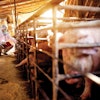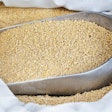In a new video, AB Vista’s Research Director Dr Mike Bedford reveals a shift in thinking related to the three hypotheses commonly used to explain the mode of action of fiber-degrading enzymes, which could have a significant influence on the choices nutritionists make regarding enzyme selection.
InHow we have been wrong on the way fiber-degrading enzymes work, Dr Bedford explores the relevance of the viscosity, cell wall and prebiotic mechanisms for corn-soy diets.
Dr Bedford reveals that, although viscosity remains a problem for wheat and barley, it plays only a very small part of the response observed when using fiber-degrading enzymes in corn-soy diets.
Analysing the cell wall mechanism – which had been thought to play an important role – Dr Bedford concludes, “When we look at how much enzyme and how much time is needed to break down cell walls completely, it is far in excess of what we actually feed the animal in real-life conditions. As a result, we don’t believe the cell wall mechanism plays much of a role, even in a corn-soy diet.”
In contrast, Dr Bedford stated that the prebiotic mechanism is emerging as the strongest for corn-soy diets.
He explains that the “prebiotic” theory should in fact more accurately be referred to as a “signalling” mechanism, “The term ‘signalling’ refers to how oligosaccharides generated by fibre-degrading enzymes ’signal’ to bacteria in the gut, stimulating them to produce their own xylanases.”
This process has a beneficial effect on fibre fermentation, both in poultry and swine – as Dr Bedford explains, “This theory suggests that xylanase affects the microbiome, changing the concentrations of short chain fatty acids (SCFAs) in the large intestine in such a way that these SCFAs are feeding back to the stomach, telling it to slow down – resulting in a significant improvement in terms of protein digestion.”
Detailing the implications of these conclusions for enzyme selection and feed formulation, Dr Bedford reveals, “Central to the signalling hypothesis is the theory that an enzyme which can produce xylo-oligosaccharides will eventually improve the ability of the microbiome to digest the arabinoxylan fraction of the diet. This gives far greater benefits in terms of energy and signalling back to the stomach – thus, we believe that feeding the right xylanase that can produce the right signals will give you the best response in commercial feed today.”
Investigations into fiber composition can provide valuable insights for producers who are keen to grasp a competitive advantage.
Dr Bedford concludes, “It is important for feed manufacturers, producers and nutritionists to examine the complex nature of fibre and best harness its intrinsic value in order to formulate a diet that optimizes animal performance – and business profitability.”
Watch the full video at AB Vista’s YouTube site: https://bit.ly/2jYHwnz.














